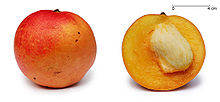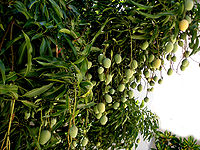- Mangifera indica
-
Indian Mango 
Scientific classification Kingdom: Plantae Division: Angiospermae (unranked): Rosids Order: Sapindales Family: Anacardiaceae Genus: Mangifera Species: M. indica Binomial name Mangifera indica
L.Mangifera indica is a species of mango in the Anacardiaceae family. It is found in the wild in India and cultivated varieties have been introduced to other warm regions of the world. It is the largest fruit-tree in the world, capable of a height of one-hundred feet and an average circumference of twelve to fourteen feet, sometimes reaching twenty.[1]
The species appears to have been domesticated about 4,000 years ago.[citation needed] The species was brought to East Asia around 400-500 BCE from India; next, in the 15th century to the Philippines; and then, in the 16th century to Africa and Brazil by the Portuguese.[2] The species was described for science by Linnaeus in 1753.[3]
Mango is the national fruit of India, Philippines and Pakistan. It finds mention in the songs of 4th century CE Sanskrit poet, Kalidasa, prior to it is believed to have been tasted by Alexander (3rd century BCE) and Chinese pilgrim, Hieun Tsang (7th century CE). Later in 16th century Mughal Emperor, Akbar planted 100,000 mango trees in Darbhanga, Bihar at a place now known as Lakhi Bagh [4]
Contents
The Australian Kensington Mango
In the latter half of the 18th century, Bowen in North Queensland, was the centre of a thriving horse trading business between North Queensland and India. The crews of the ships coming in from India bought many items back with them, including seeds of the Mangifera Indica.
The Bowen Harbourmaster and Customs Officer at the time, Mr G.E. Sandrock, collected a quantity of mango seeds from the sailors and planted them on his property “Woodlands” just outside Bowen. As this initial stock came into fruit, seeds from the better quality and better producing trees were separately collected and Mr Sandrock gave these to a friend of his, Mr McDonald, who planted them on his property at Adelaide Point near Bowen.
A local farmer, Mr Harry Lott, selected a good stringless type of fruit from McDonald’s harvests and used the seeds to start a small orchard on his property, “Kensington”, in the late 1880s.
Mr Lott found that his mango variety sold well at the local markets due its smooth stringless flesh, and attempted to monopolise the variety. Other local growers unfortunately got hold of seeds by fair and foul means, though, and within a few years this style of mango was widely distributed through the Bowen and Burdekin regions.
The name “Kensington” has remained although this variety is also called “Bowen Special”.[5]
Medicinal properties
Mangiferin (a pharmacologically active flavonoid, a natural xanthone C-glycoside) is extracted from Mango at high concentrations from the young leaves (172 g/kg), bark (107 g/kg), and from old leaves (94 g/kg).[6] Mangiferin shows an exceptionally strong antioxidant[7] capacity. It has a number of pharmacological actions and possible health benefits. These include antidiabetic[8], antioxidant, antifungal,[9] antimicrobal, antiinflamatory, antiviral, hepatoprotective[10], hypoglycemic, anti-allergic[11] and anticancer activity.[12],[13]. Along with Salacia it is being investigated for its possible anti-obesity action.[14]
In ayurveda, one of its uses is clearing digestion and acidity due to pitta (heat), sometimes with other mild sours and shatavari (Asparagus racemosus) and guduchi (Tinospora cordifolia).
References
- ^ (1846). The Missionary guide-book, p.180. Seeley, Burnside, and Seeley.
- ^ Gepts, P. (n.d.). "PLB143: Crop of the Day: Mango, Mangifera indica". The evolution of crop plants. Dept. of Plant Sciences, Sect. of Crop & Ecosystem Sciences, University of California, Davis. http://www.plantsciences.ucdavis.edu/gepts/pb143/crop/mango/mango.htm. Retrieved October 8, 2009.
- ^ GRIN (May 5, 1997). "Mangifera indica information from ARS/GRIN". Taxonomy for Plants. National Germplasm Resources Laboratory, Beltsville, Maryland: USDA, ARS, National Genetic Resources Program. http://www.ars-grin.gov/cgi-bin/npgs/html/taxon.pl?23351. Retrieved October 8, 2009.
- ^ "National Fruit". Govt. of India Official website. http://india.gov.in/knowindia/national_fruit.php.
- ^ http://www.goldendrop.com.au/mangoes.html
- ^ Barreto J.C., Trevisan M.T.S., Hull W.E., Erben G., De Brito E.S., Pfundstein B., Würtele G., Spiegelhalder B., Owen R.W.,"Characterization and quantitation of polyphenolic compounds in bark, kernel, leaves, and peel of mango (Mangifera indica L.)". Journal of Agricultural and Food Chemistry 2008 56:14 (5599-5610)
- ^ Delgado-Hernández R., Rodeiro I., Garcia D., Pardo-Andreu G.L., Garrido B., Morales C.I., Reynaldo G., Nuñez-Selles A.J. "From the ethnomedicine to the clinical controlled investigation in Cuba. Mangifera indica stem bark extract (Vimang), like an instructive example" Basic and Clinical Pharmacology and Toxicology 2009 105 SUPPL. 1 (144)
- ^ Girón M.D., Sevillano N., Salto R., Haidour A., Manzano M., Jiménez M.L., Rueda R., López-Pedrosa J.M. ,"Salacia oblonga extract increases glucose transporter 4-mediated glucose uptake in L6 rat myotubes: Role of mangiferin Clinical Nutrition 2009 28:5 (565-574)
- ^ Kanwal Q, Hussain I, Latif Siddiqui H, Javaid A.,"Antifungal activity of flavonoids isolated from mango (Mangifera indica L.) leaves." Nat Prod Res. 2010 Dec;24(20):1907-14
- ^ Daud NH, Aung CS, Hewavitharana AK, Wilkinson AS, Pierson JT, Roberts-Thomson SJ, Shaw PN, Monteith GR, Gidley MJ, Parat MO.,"Mango extracts and the mango component mangiferin promote endothelial cell migration." J Agric Food Chem. 2010 Apr 28;58(8):5181-6
- ^ García Rivera D., Hernández Balmaseda I., Álvarez León A., Cancio Hernández B., Márquez Montiel L., Garrido Garrido G., Cuzzocrea S., Delgado Hernández R. "Anti-allergic properties of Mangifera indica L. extract (Vimang) and contribution of its glucosylxanthone mangiferin" Journal of Pharmacy and Pharmacology 2006 58:3 (385-392)
- ^ Williamson Em., (ed) "Major Herbs of Ayurveda" Churchill Livingstone 2002
- ^ García-Rivera D, Delgado R, Bougarne N, Haegeman G, Berghe WV/."Gallic acid indanone and mangiferin xanthone are strong determinants of immunosuppressive anti-tumour effects of Mangifera indica L. bark in MDA-MB231 breast cancer cells." Cancer Lett. 2011 Jun 1;305(1):21-31
- ^ Li Y., Huang T.H.-W., Yamahara J .,"Salacia root, a unique Ayurvedic medicine, meets multiple targets in diabetes and obesity",.Life Sciences 2008 82:21-22 (1045-1049)
External links
- Crop of the Day: Mango, Mangifera indica has a list of helpful resources about this species.

This Anacardiaceae article is a stub. You can help Wikipedia by expanding it.

